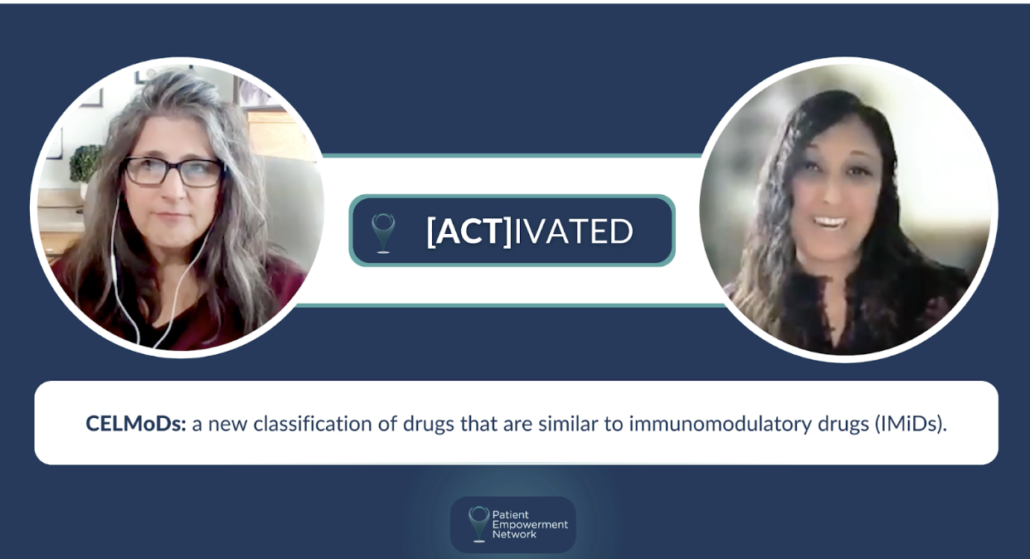Enhancing Access and [ACT]IVATION in CAR T-cell Therapy
Patient Empowerment Network (PEN) has a strong commitment to providing educational content and to empowering patients and care partners in CAR T information. CAR T-cell therapy has unique eligibility and care requirements, and it’s essential for patients and families to inform themselves about the full CAR T-cell therapy process. With these objectives in mind, PEN initiated the [ACT]IVATED CAR T program, which aims to inform, empower, and engage patients to stay well-informed about CAR T therapy.
CAR T-cell therapy can be a powerful treatment option for many myeloma patients, but there are barriers to access and treatment refinements that need to be addressed for some patient populations. One key disparity is the fact that African American patients make up about 20 percent of the U.S. myeloma population but comprise less than 5 percent of myeloma clinical trial participation. PEN remains steadfast in helping to decrease disparities by offering resources on CAR T-cell therapy to aid in advocacy and awareness efforts.
Cancer survivor Lisa Hatfield interviewed experts Dr. Sikander Ailawadhi from the Mayo Clinic and Dr. Krina Patel from The University of Texas MD Anderson Cancer Center as part of [ACT]IVATED CAR T.

CAR T-Cell Therapy Eligibility Requirements
Though some myeloma patients may think eligibility to CAR T is more difficult than stem cell transplant, Dr. Krina Patel stated this is not the case. Dr. Patel also shared the success that she’s seen in patients over time. “…I have so many patients that are over a year, two years out without any therapy now. And they’re doing fantastically.
And, and again, my patients with comorbidities and my older patients, they’re the ones who benefit when we’re not on any therapy because continuous therapy ends up causing more toxicity for them. And so I think it’s really, really important to speak up to your doctor and just say, this is something I’d really be interested in.”
Dr. Patel continued to explain a key difference in inpatient versus outpatient CAR T-cell therapy eligibility requirements. Though patients who stay in the hospital for their CAR T-cell therapy don’t need a care partner with them, this isn’t the case for outpatients since a care partner is needed to monitor the patient’s symptoms. “…if you’re going to do it with outpatient, then yes, because again, when things go wrong, they can go wrong pretty fast, especially with the ICANS, neurotoxicity. So ICANS, most patients just have a little bit of trouble writing or they might have a little bit of trouble with confusion, but if that happens, you might not remember or know who to call if you’re not feeling well, right.”

CAR T-Cell Therapy Disparities
Some CAR T-cell therapy patient groups and patient types have shown different responses to therapy. One study concluded that African American patients were more likely to experience side effects from CAR T. Dr. Sikander Ailawadhi discussed research efforts that are working toward improvements. “What we are trying to do to mitigate some of these side effects, there are now studies which are giving either some low doses of steroids as a prophylaxis before, right around the time of CAR T, so that side effects may not happen. Studies that are giving a low dose or even standard dose of what’s called tocilizumab (Actemra), toci, or tocilizumab.”
African American patients in general have inflammatory disorders at a higher rate, and inflammation can impact CAR T-cell therapy side effects. Dr. Ailawadhi shares how patient monitoring is increased for African American patients at the Mayo Clinic. “…CRS, which is an immune system mediated inflammatory response, I can imagine that some of it might be higher in African Americans.
So, in our clinics, what we are doing is when we are monitoring the patients, every patient is getting monitored the same way, but when it’s an African American patient, we are putting a little bit more focus on those inflammatory markers that can sometimes start showing up even before the CRS happens.”
Side effect prevention also helps with reducing other barriers to CAR T as a treatment option. Dr. Ailawadhi shared, “…by preventing the side effects, we are being able to give the treatment in a way that the patients may have lesser side effects and can get it done closer to home or at home sometimes, and their time to stay in the hospital is lesser. You can imagine that some of these barriers are being further mitigated.”
Solutions to Overcome CAR T Disparity Gaps
Some myeloma patient groups may face barriers to or disparities in CAR T-cell therapy, but some efforts to solutions are underway. Dr. Ailawadhi discussed some roadblocks to CAR T care for Black and Latinx patients. “A lot of times they are sociodemographic, patients need to take time away from work. They have to have a caregiver, they have to have appropriate insurance approvals for certain things. They have to be able to go to a center that may be close to them.
These centers are hopefully going to be able to bring some other resources like social workers, navigators, et cetera, to help that patient get onto the trial. And then there is sometimes lack of awareness of CAR T, lack of awareness of clinical trials per se, clinical, and there are fears, anxiety, scares around getting on clinical research.”
Myeloma patients who live in rural areas may now have options to access CAR T-cell therapy through the use of telemedicine and remote monitoring. Dr. Ailawadhi painted a detailed picture of how his care of an international patient has been handled from her introduction through the care she’s receiving today. “She had some family members and some means that she could actually come here, so she came to the U.S., did a consult, we did a visit, we took over her treatment, she got CAR T, but then a month or so after that she was doing fine and she wanted to go back home.
She was here with some family members living in a foreign country, not speaking the language, et cetera. Her children were very supportive and spoke English. So, she went back and I still continue to do video visits with her just to see how she’s doing, monitor her disease, she sends me records through the electronic medical system portal, I can see her labs, and I think it gives me peace of mind that I’m keeping an eye on it, it gives her peace of mind.”
Additional barriers to CAR T access include language and cultural barriers. Dr. Ailawadhi discussed how Spanish language versions of CAR T educational materials are being introduced. And he shared the idea that patients are often more receptive to healthcare providers who look and speak like them. “…we have African American, Hispanic, Asian clinical research coordinators in our teams, and we have noticed a clear difference in the patient’s understanding their ability to ask questions, their willingness to ask questions and clear out their barriers if it is given to them in a culturally sensitive, culturally appropriate manner.”
[ACT]IVATED CAR T Program Resources
The [ACT]IVATED CAR T program series takes a three-part approach to inform, empower, and engage myeloma patients and patient groups who experience health disparities. The series includes the following resources:
- [ACT]IVATED Expert Interviews
- [ACT]IVATED Patient Vignette
- [ACT]IVATED Toolkit
- [ACT]IVATED CAR T Resources
Though there are some special eligibility requirements for CAR T-cell therapy and some care and treatment disparities exist, CAR T can be a powerful treatment option for many patients and continues to increase with equity and access improvement efforts. We hope you can take advantage of these valuable resources to assist in building knowledge about CAR T-cell therapy for yourself or for your loved one and to help expand awareness around CAR T.

![[ACT]IVATED logo](https://powerfulpatients.org/wp-content/uploads/ACTIVATED-180x180.png)


